Scabies Specialist Advice – London
Home » Conditions » Scabies Specialist Advice – London
Get Rid Of The Itch Today
Not sure about your condition? Get in touch now, there is no reason for you to wait.
Award winning dermatology service, with over 20 years of experience
Short waiting lists, on some occasions offering same week appointments
Safe environment, in Care Quality Commission approved facilities
scabies treatment in london
Scabies is a common, extremely itchy rash caused by a mite called Sarcoptes scabiei. These parasites eat the outer (epidermal) layer of the skin cannot be seen with the naked eye although their tiny burrows might be visible. When a person is initially infected it can take up to 8 weeks before the itching begins as it takes a while for the body to develop an allergic reaction to the mite.
Scabies mites tend to favour warm, moist areas such as the external genitalia, beneath the breasts, between the buttock folds, webs of the fingers or toes and under the fingernails. However, they can be found residing anywhere on the body, including the palms of the hands and soles of the feet, though the face and neck are usually spared. People become infected with the mites either via prolonged direct skin contact with someone who is already infected or, much less commonly, by using infested bath towels, clothing or bedding. Pets do not carry the mites that infect humans and therefore spread from animals to humans does not occur.
WHAT CAUSES SCABIES?
Scabies is caused by small burrowing mites in the skin.
Scabies mites tend to favour warm and moist areas such as the external genitalia, beneath the breasts, between the buttock folds, webs of the fingers or toes and under the fingernails. However, they can be found residing anywhere on the body, though the face and neck are usually not affected.
Scabies are often spread by direct skin to skin contact with someone who has the condition. This must be prolonged contact, a quick handshake or hug usually isn’t enough to spread scabies.
WHAT DOES SCABIES LOOK LIKE?
Multiple tiny red insect bites in a row are the typical finding with scabies. The superficial burrows created by the mites appear as small curves or lines. Due to the excessive itchiness, scaly inflamed scratch marks may also become visible, and scabies infestation often resembles severe eczema (see image).
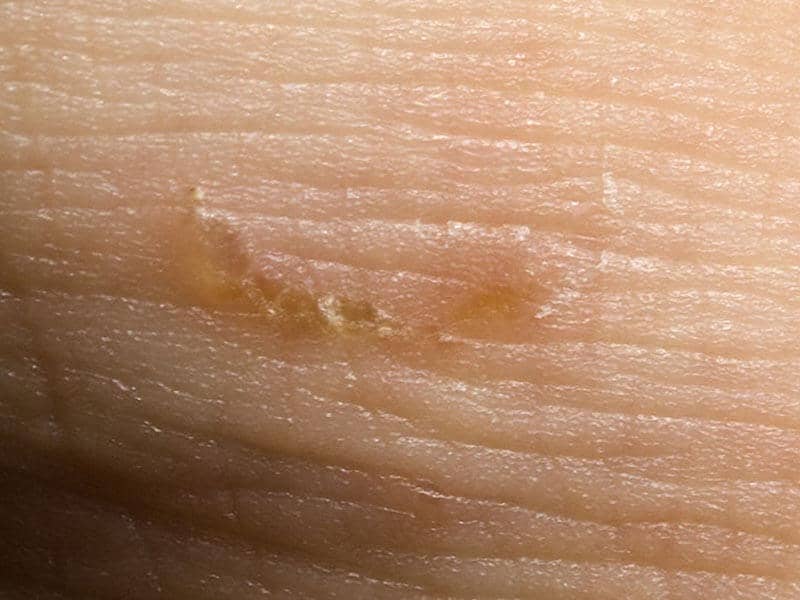

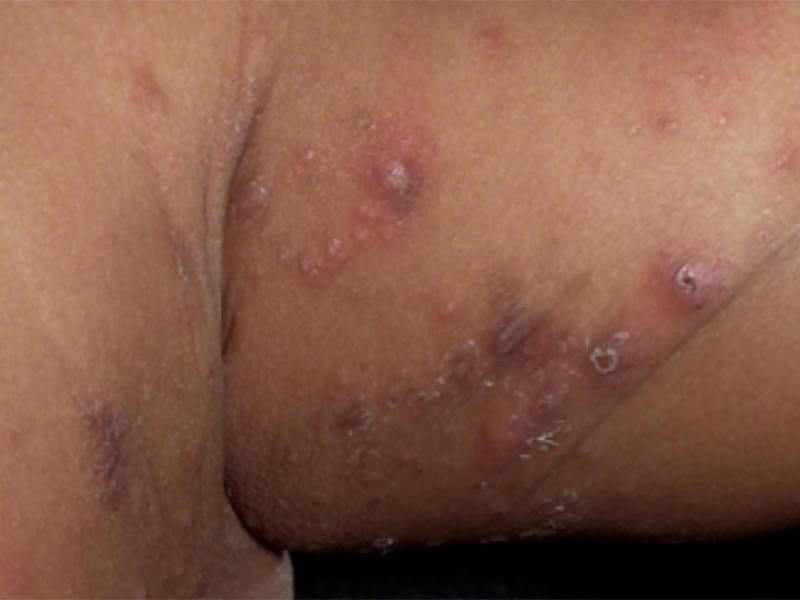
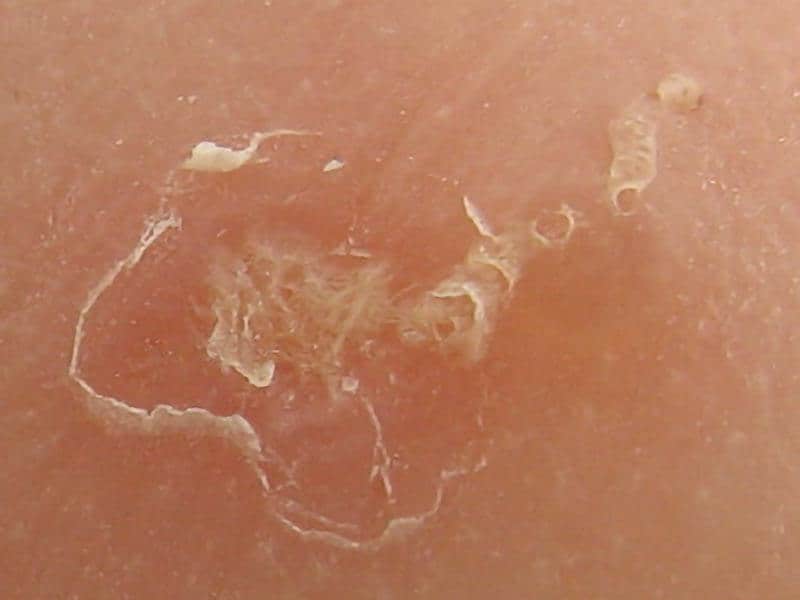
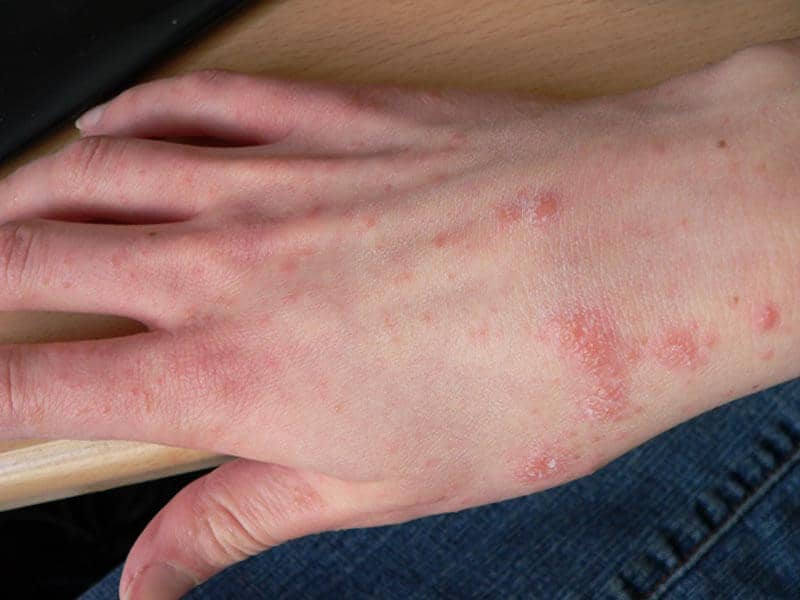
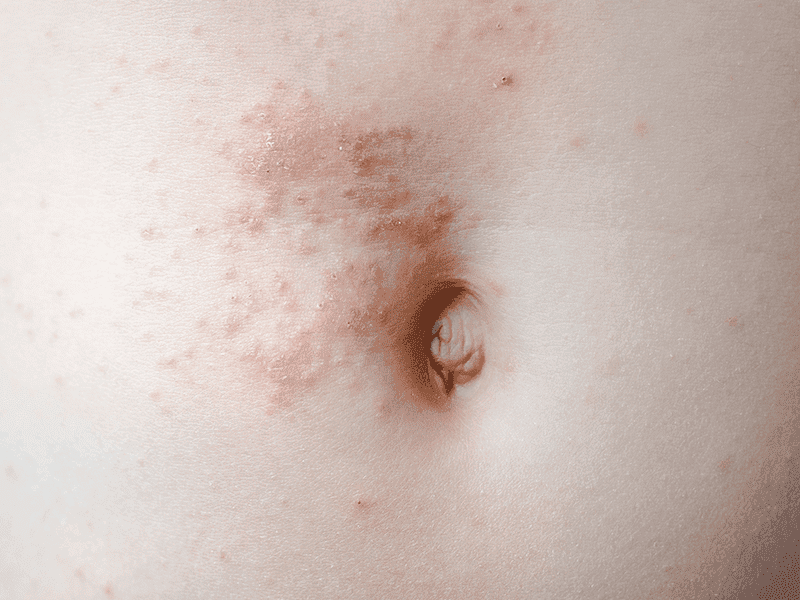
WHAT IS IT LIKE TO HAVE SCABIES?
Intense itching, particularly at night and in warm environments, is the main complaint with this condition. Though there are generally no serious health consequences of uncomplicated scabies, it is important to seek treatment as soon as possible, otherwise symptoms can persist for months or even years.
A rare, highly-contagious, form of the diease referred to as crusted or Norwegian scabies, which involves extensive areas of the body being infested with a large number of mites can affect those whose natural defence mechanisms are weakened such as people who have cancer or AIDS.
HOW CAN SCABIES BE TREATED?
The most well-established treatment for scabies involves the application of a medicated-cream containing permethrin, which is highly effective at killing the mites. However, if this fails to work another lotion containing a medication known as malathion can be used.
Due to the fact that the symptoms are caused by an allergic reaction it can take some time after the eradication of the mite before the itching completely disappears.
For the more severe, crusted form of scabies a tablet-medication called Ivermectin is given.
It is important to avoid close bodily contact or the sharing of items that have been used by others during treatment to prevent re-infection. It is also advisable for all close contacts (household members and sexual contacts) to undergo treatment, even if they have no symptoms, to prevent the condition recurring.
Our scabies specialists at the Harley Street Dermatology Clinic can offer effective treatment to patients in London (and nationally).
FREQUENTLY ASKED QUESTIONS
WHAT CAN I DO AT HOME IF I HAVE SCABIES?
- Wash all the bedding and clothing in the house at a high temperature on the first day of treatment
- Put any clothing that cannot be washed into a sealed bag for 3 days until the mites die
- Stop babies and children from sucking the treatment lotion from their hands by putting mittens on them
- Don’t have sex or close physical contact until the course of treatment is finished
- Don’t share bedding, clothing or towels with someone with scabies
HOW LONG DOES IT TAKE TO GET RID OF SCABIES?
You will be able to go back to school/work 24 hours after the first treatment. It may take a couple of weeks for the itching to stop even after the mites have died.
IS SCABIES CAUSED BY BAD HYGINE?
No, scabies has nothing to do with poor hygiene, anyone can get it. Scabies is contagious and can spread easily from skin to skin contact so this should be avoided until treatment is complete.
CAN I GET SCABIES FROM MY PETS?
You cannot get scabies from pets.
WHERE ARE SCABIES RASHES MOST COMMONLY FOUND?
The burrows of scabies typically are seen in folds of skin. Even though any part of the body can be affected, the rashes are most often found:
- between the fingers
- in the armpits
- around the waist
- on the inside of the wrists
- on the inner elbows
- on the soles of the feet
- around the breasts
- around the genitals
- on the buttocks
- on the knees
In young children, it is also common to see rashes
- on the scalp
- palms of the hands
- soles of the feet
HEAR FROM OUR PATIENTS
Start Your Journey With Us
Please fill in this form and one of our team will give you a call back to arrange a consultation with one of our expert dermatologists.
WHY TREAT YOUR SCABIES AT THE HARLEY STREET DERMATOLOGY CLINIC?
Having the right dermatologist is important especially when you have a chronic skin condition that will require ongoing treatment. We want you to feel confident that we’re providing you with the best possible care. We also want you to feel as comfortable as possible with your scabies specialist.
The Harley Street Dermatology Clinic specialises in conditions affecting the skin, hair and nails. Our goal is to provide all the care that you need when you’re experiencing these kinds of problems. We want to make it easy for you to access the best quality scabies treatment London.
The clinic is conveniently located in Central London, so it’s easy to visit us if you need to see a dermatologist. You will find yourself in a very comfortable and welcoming environment. We have created a relaxing space where you will receive the highest quality of care. We are regulated by the Care Quality Commission, are part of the British Association of Dermatologists and are top rated by patients of Doctify so you can be sure of safe and effective treatment with us.
Latest INSIGHTS AND ADVICE

Winter Skin Conditions
Winter weather can take a heavy toll on our skin. We are constantly stepping between the warm, heated rooms indoors and the cold, dry air outside. We also tend to wrap up more at this time of year, which can cause problems if clothes are

Should You Worry About Sun Damage in Winter?
Sun damage isn’t usually a problem in the UK in winter. The UV rays are not usually strong enough at this time of year to cause sunburn, but they can still affect your skin. Sun damage is responsible for many of the skin conditions treated

Are The Effects of Skin Conditions Underestimated?
Skin conditions can be embarrassing, uncomfortable and tricky to treat, but they are often dismissed as minor or cosmetic problems. It’s time we all took our skin more seriously.







